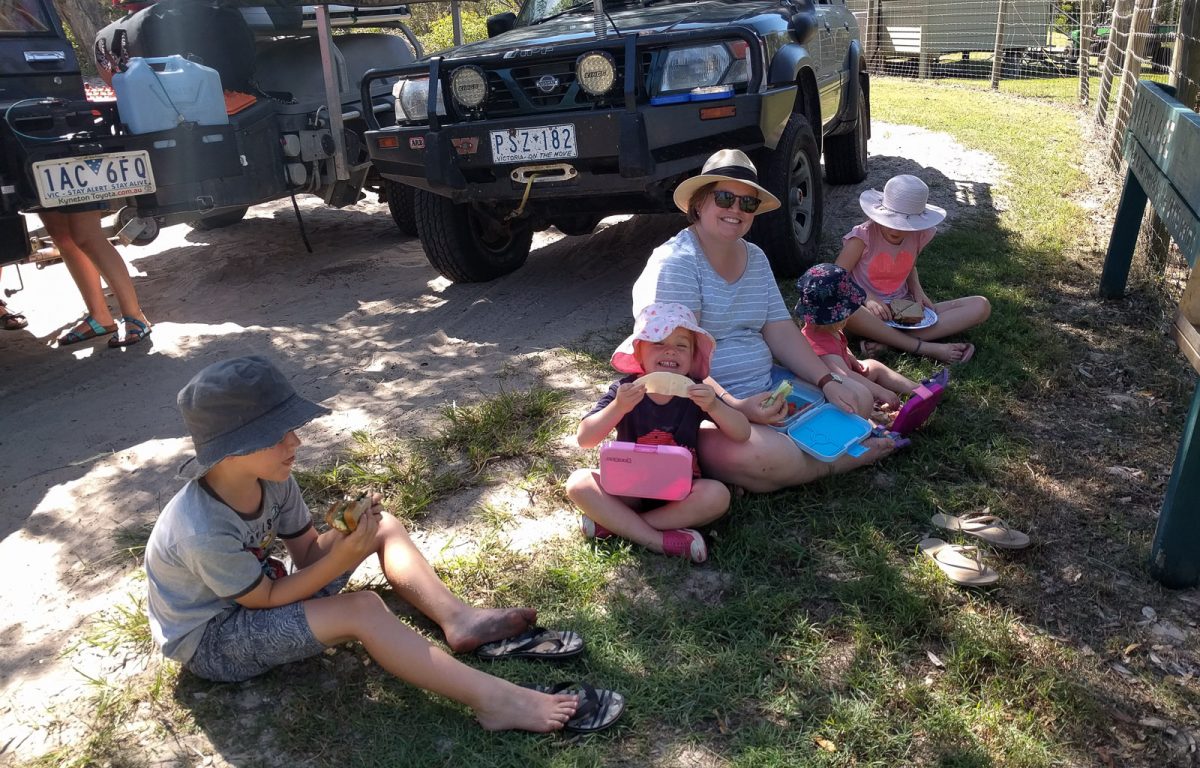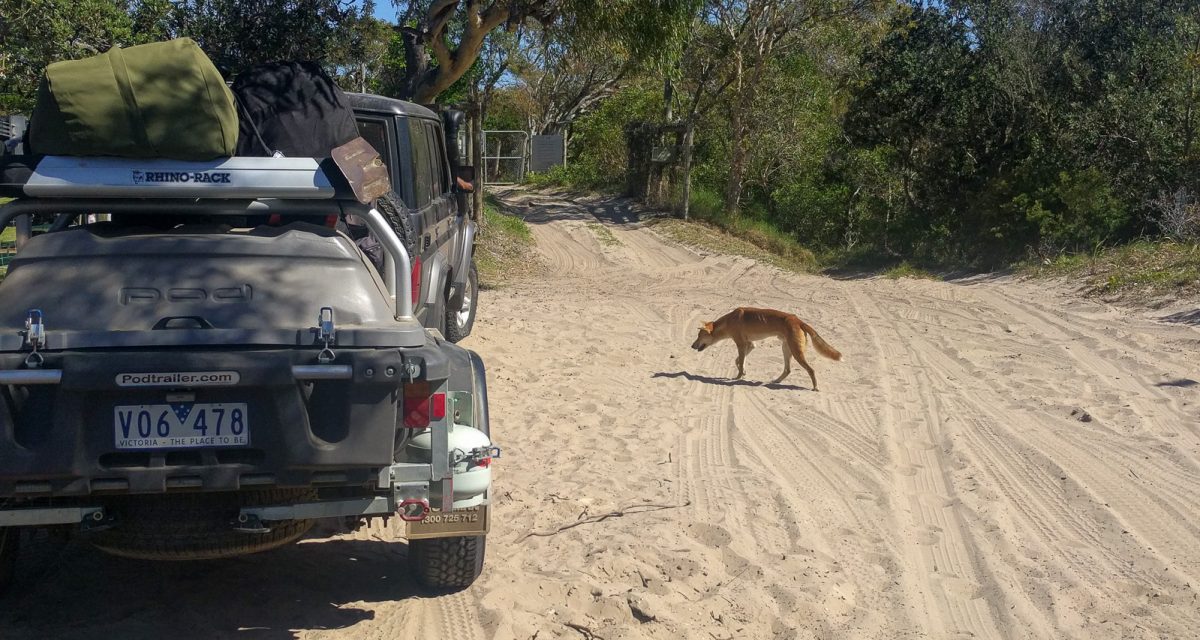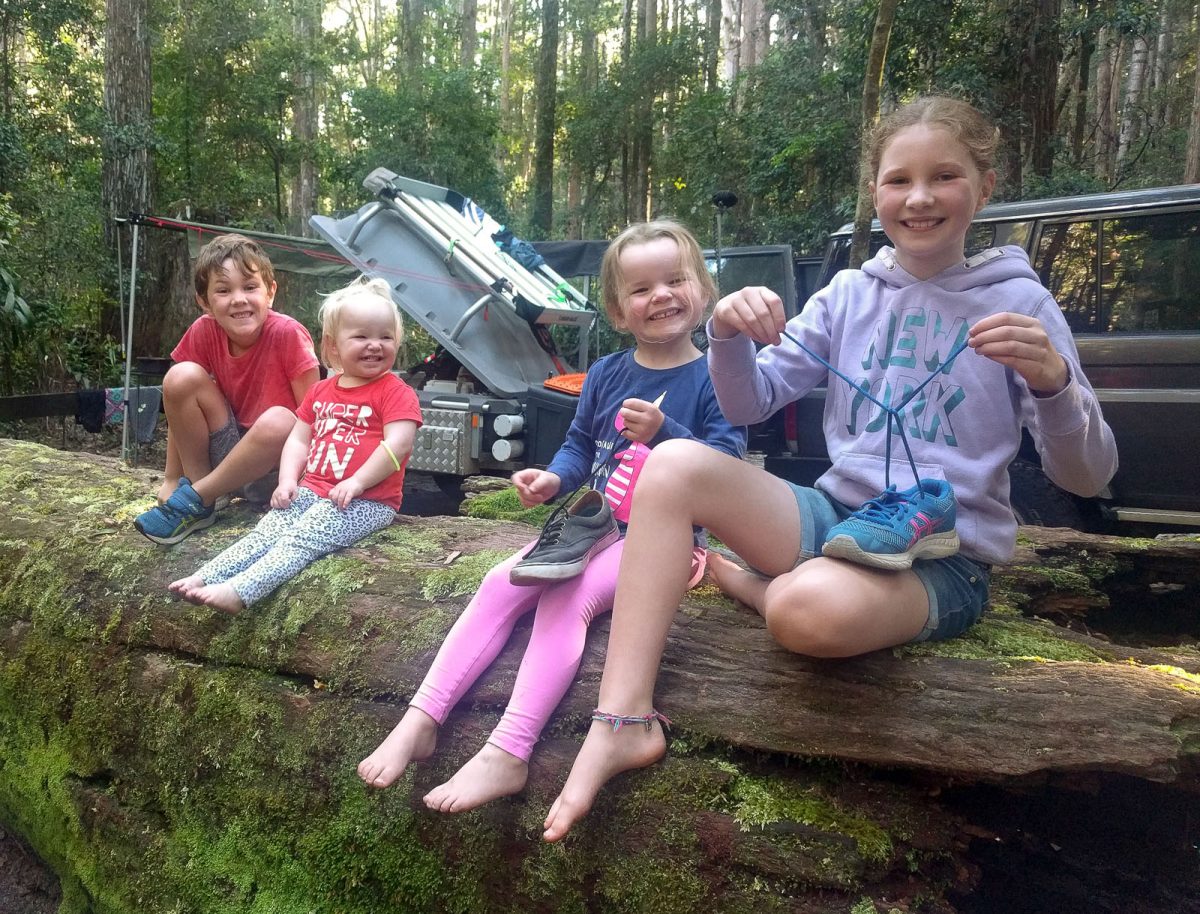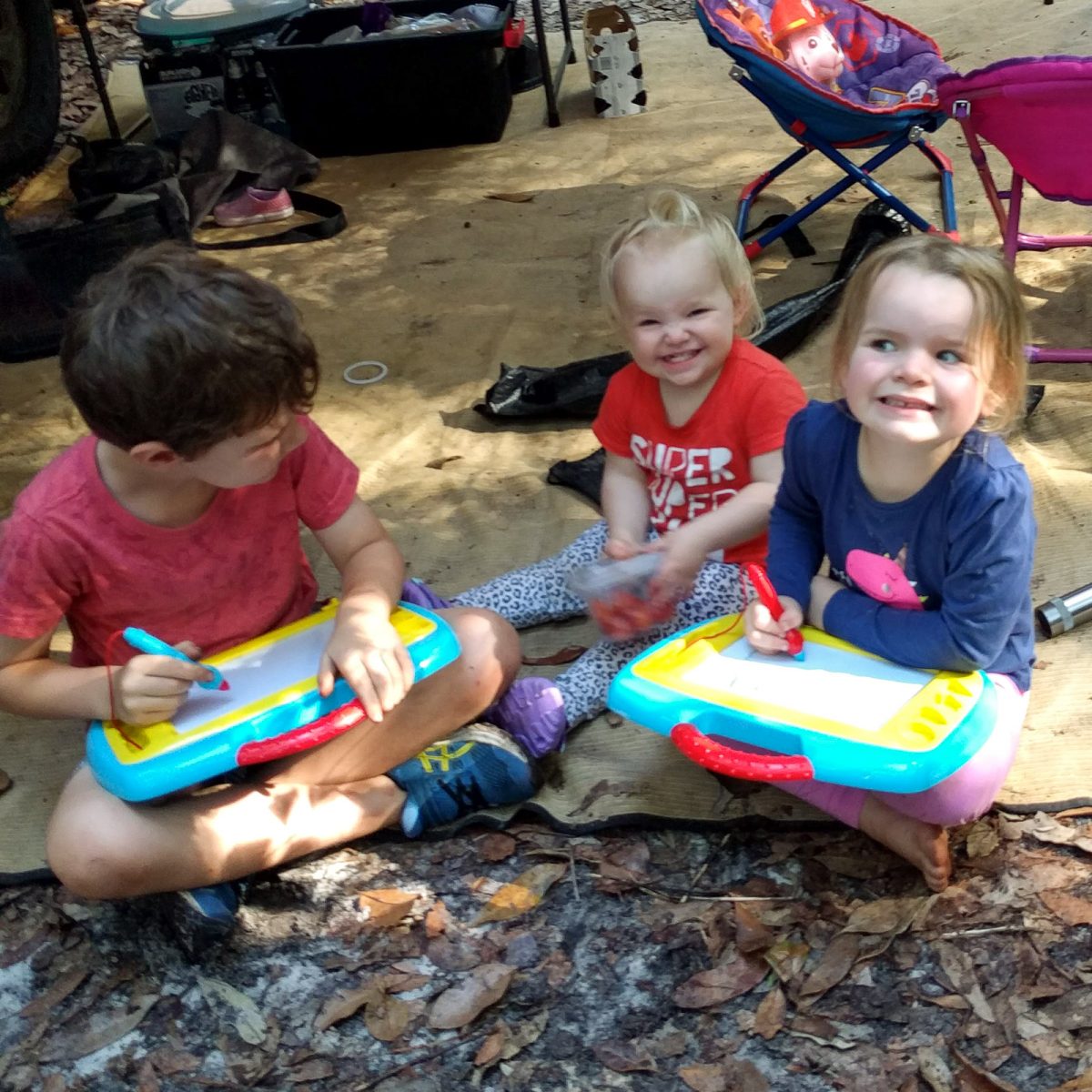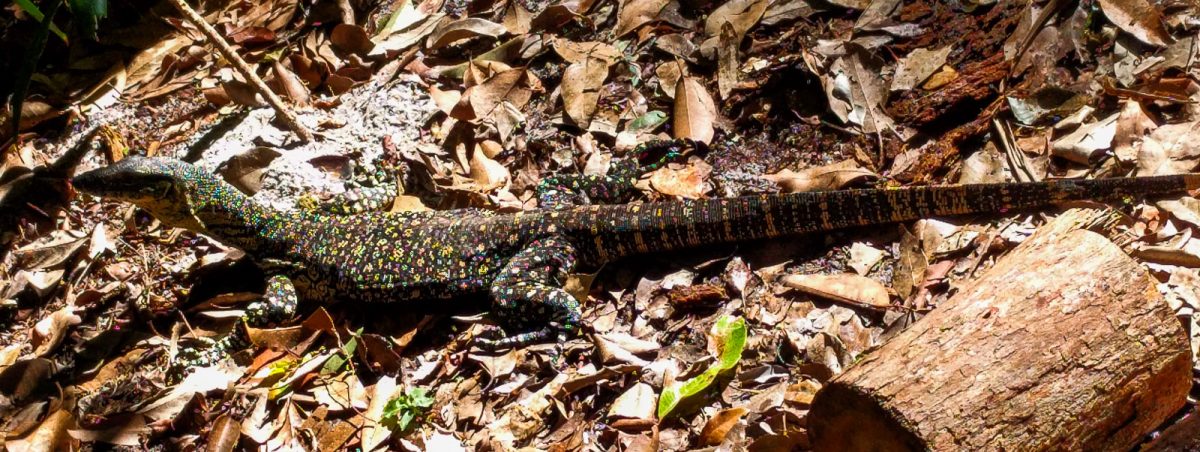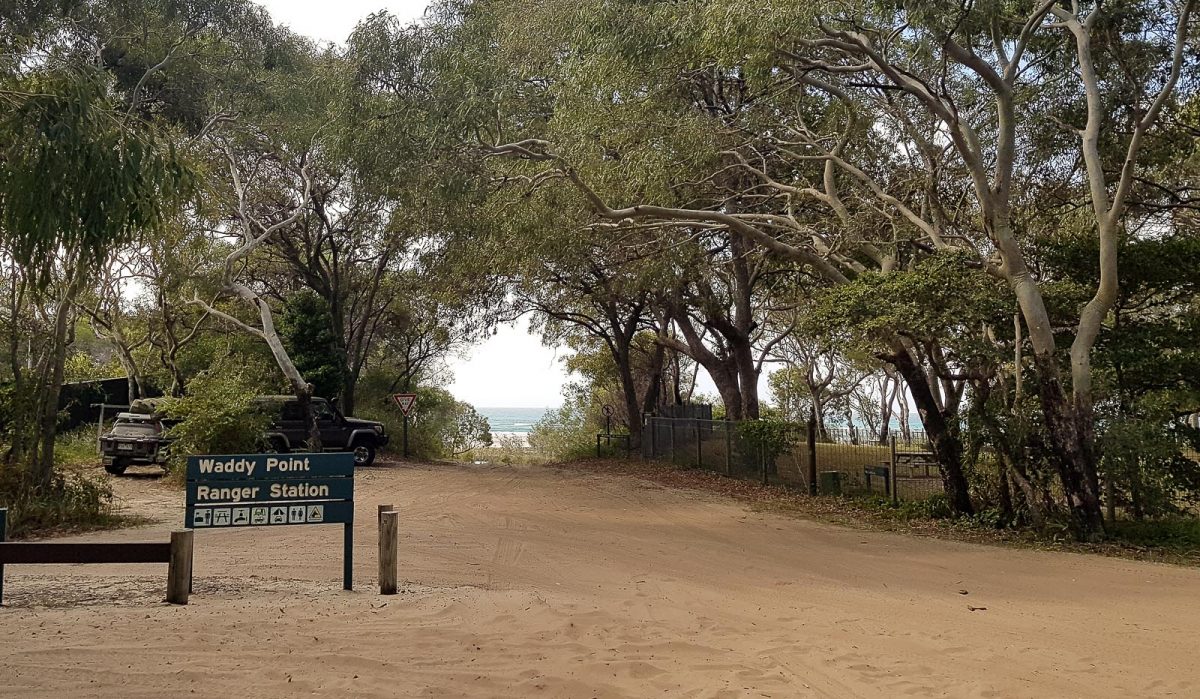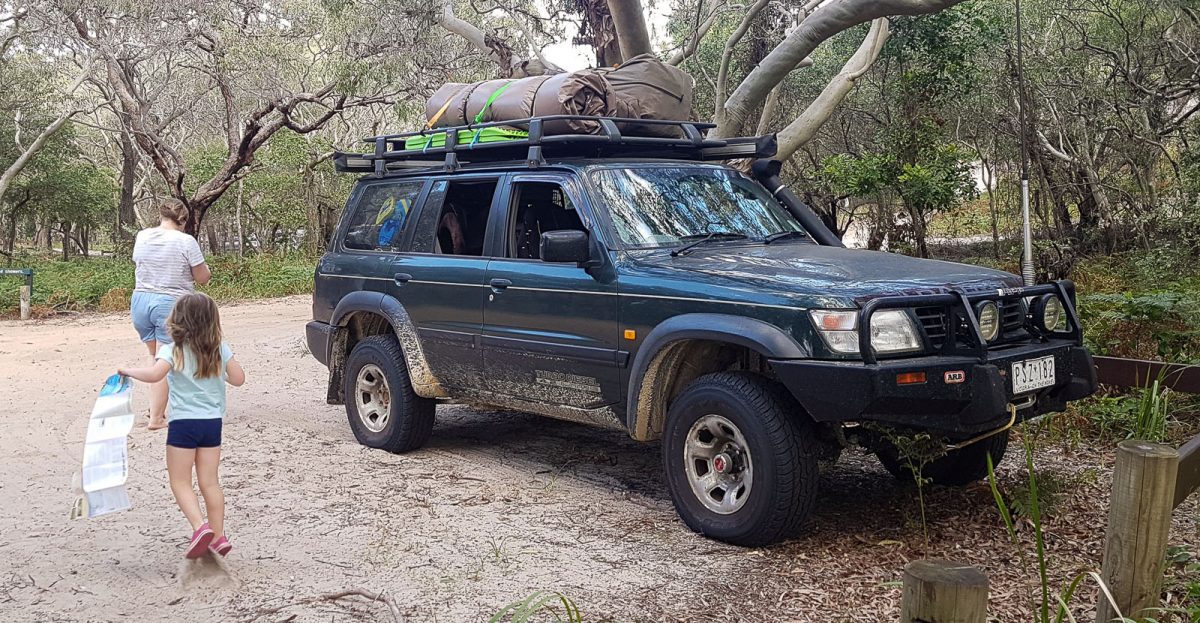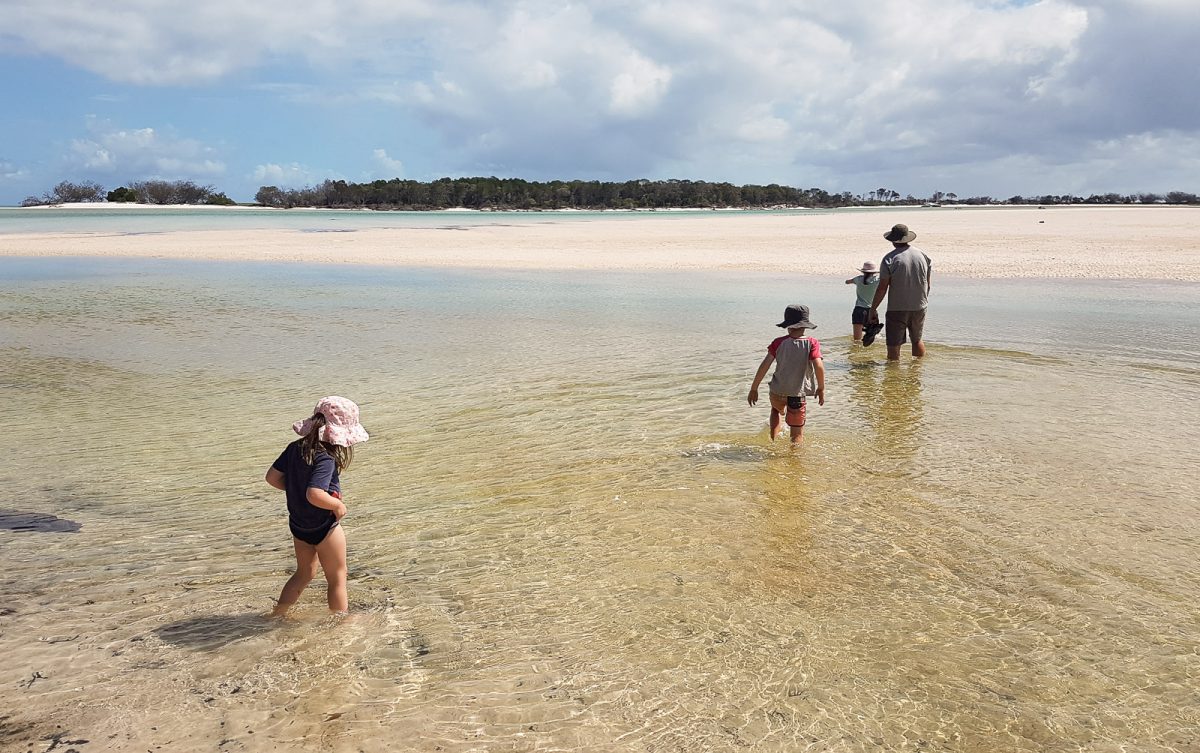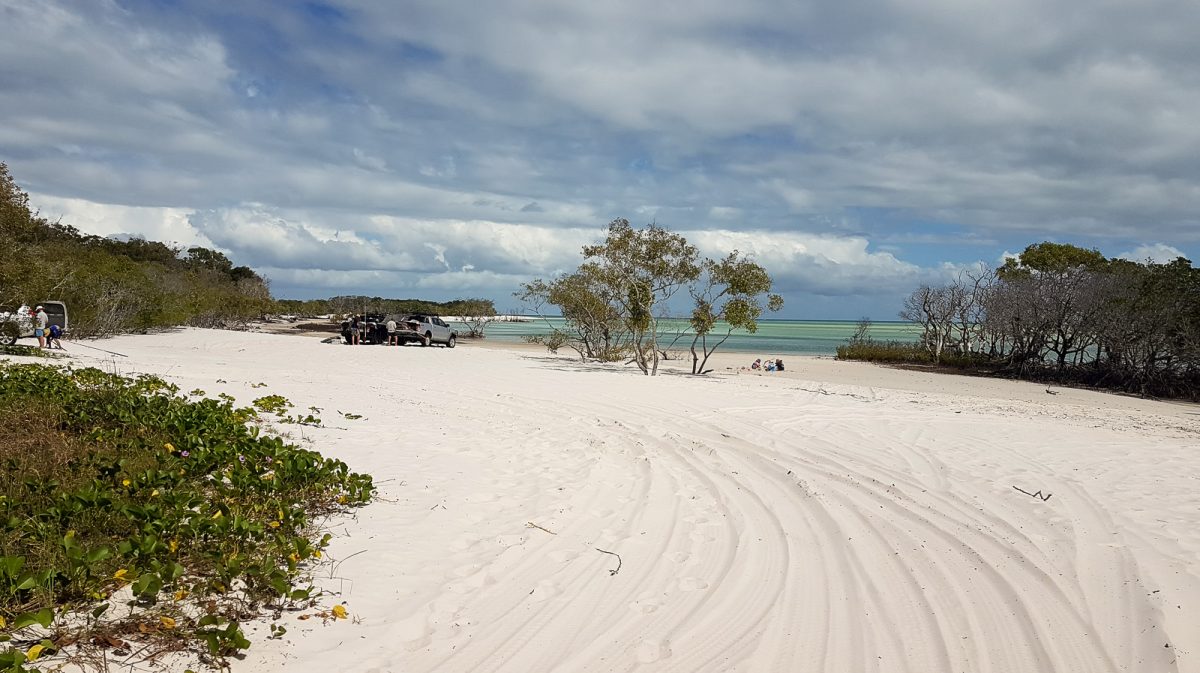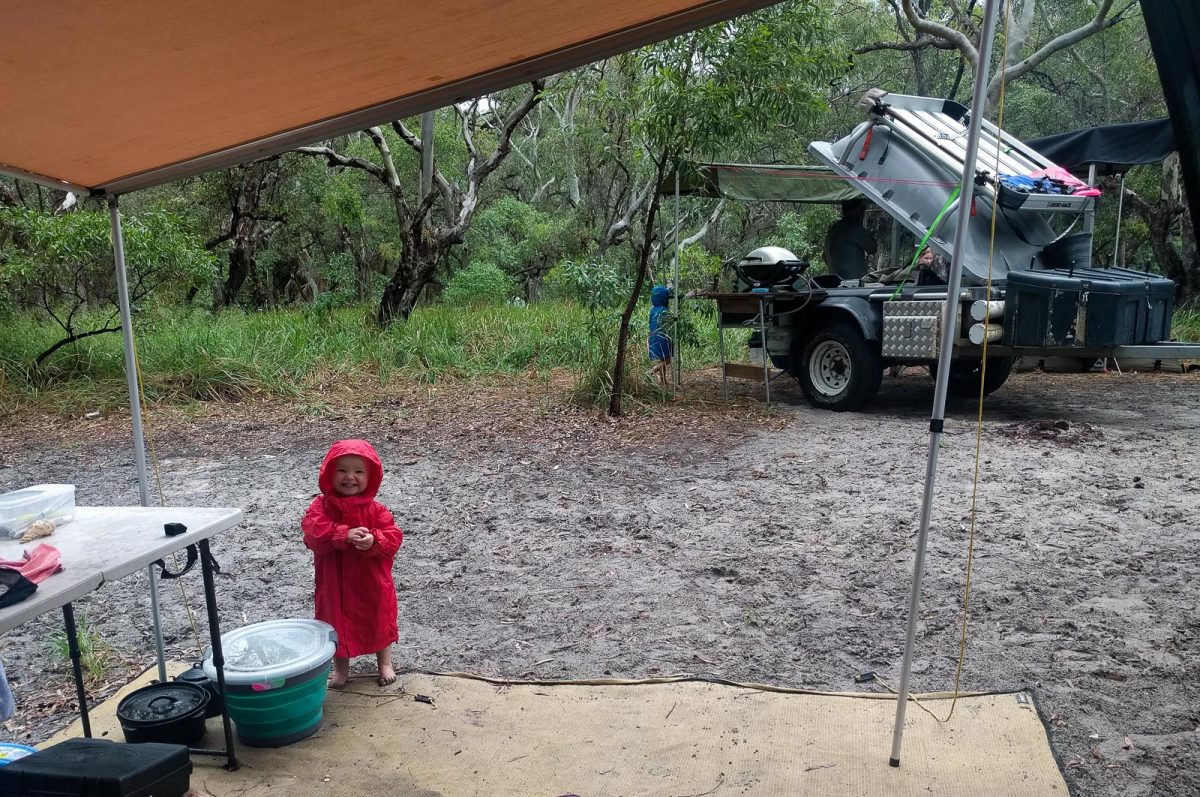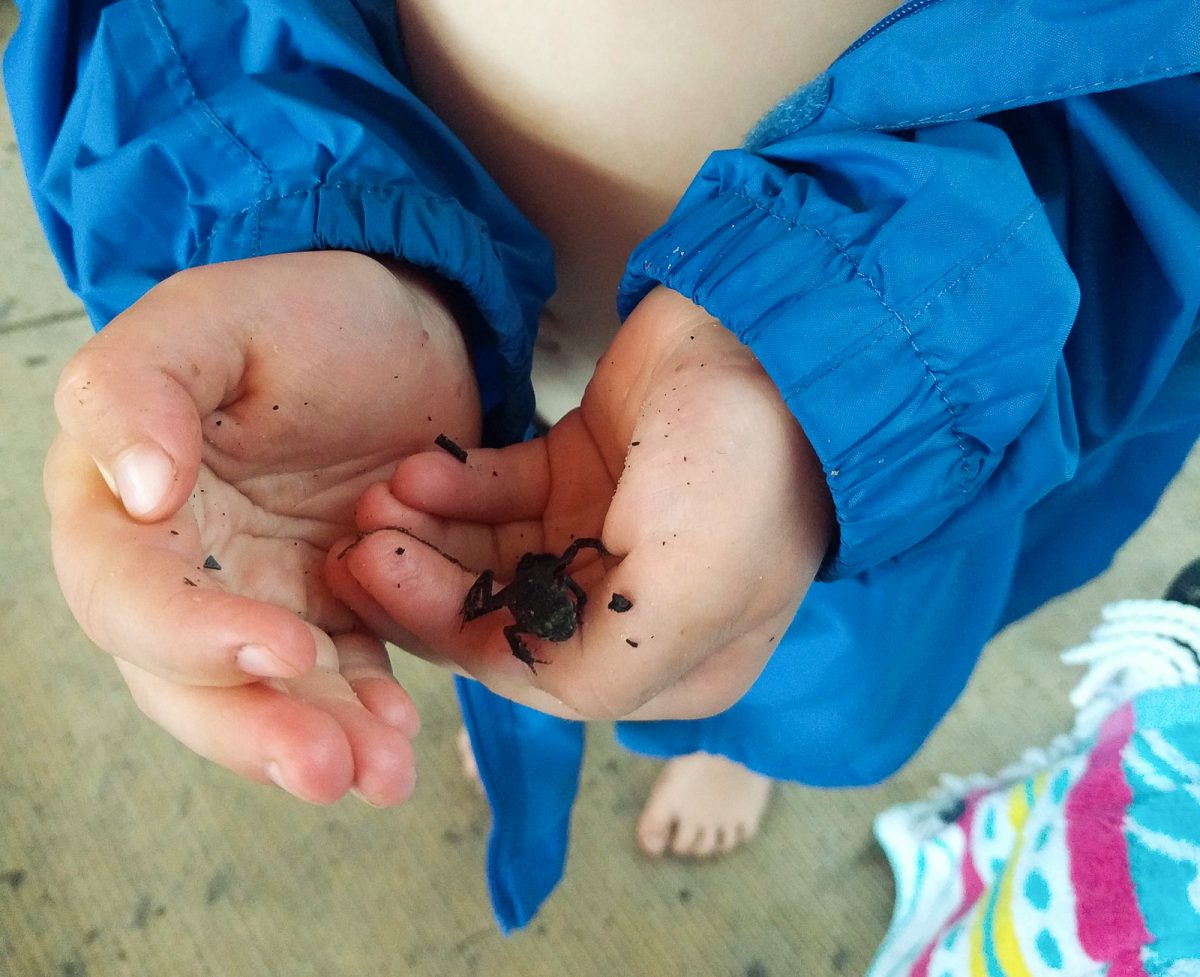Fraser has got to be on most four wheel driver’s top-10 – pristine beaches and lakes, heaps to see, great driving, great camping spots and great atmosphere. We decided to run a trip in the April school holidays, and having young kids ourselves we wanted to explore the island at a leisurely pace and provide plenty of opportunities for the kids to play, and to sit back and relax.
We ended up with 2 families on the trip, myself and my wife Kim were in the Patrol with our 2 kids – Pip (4) and Libby (1), and along for the ride was Shannon and Bec in their Land Cruiser with Emily (9) and Tom (6) in the back, towing a trailer.
The plan was to get up to Fraser as quickly as we could, spend 7 nights and get back home before Easter weekend started.
Getting there, days 1-3
We drove up over 3 days, leaving Bendigo on Friday after work. We basically just drove as far as we could in a day, and then used Wiki Camps to find a nearby free camp. Using the app worked quite well and we stayed in West Wyalong and Dalby for the first 2 nights. The other guys followed the same route but stayed in different towns.
We met up at Inskip Point on Sunday night after fueling up and buying our ferry tickets at the servo in Rainbow. Shannon and I set up camp, while Kim and Bec took the kids down to the beach for a swim before dinner.
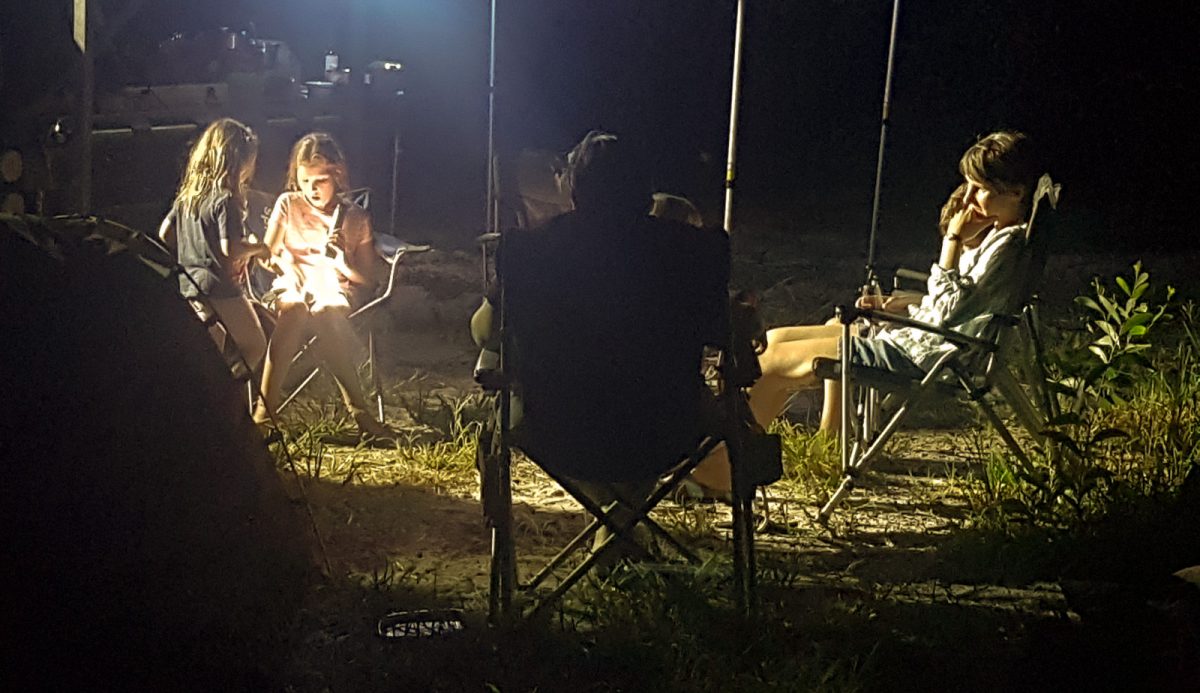
Day 4 & 5 – Central Station
We got up and packed up camp, Kim and Bec took some washing into Rainbow to get that sorted, while us Dad’s took the kids down for more swimming and playing on the beach.
Once we were ready to go we drove down to the point to get on the barge. Now there’s a Facebook group called “I got bogged at Inskip Point“, and I think myself and Shannon had spent possibly too long watching videos of tourists driving onto the beach there on highway pressures and going down on the sand. There are some blokes that sit there on the beach entrance and film everyone – we didn’t want to end up on Facebook.
We aired down to 15-16psi, which I find is about right on soft sand, and with trepidation, we drove down onto the beach. It was a complete anti-climax, we basically just drove like we were on a freeway over to the barge. I’m still scratching my head as I wonder how it’s physically possible to get bogged here – maybe it’s softer at different times of the year.
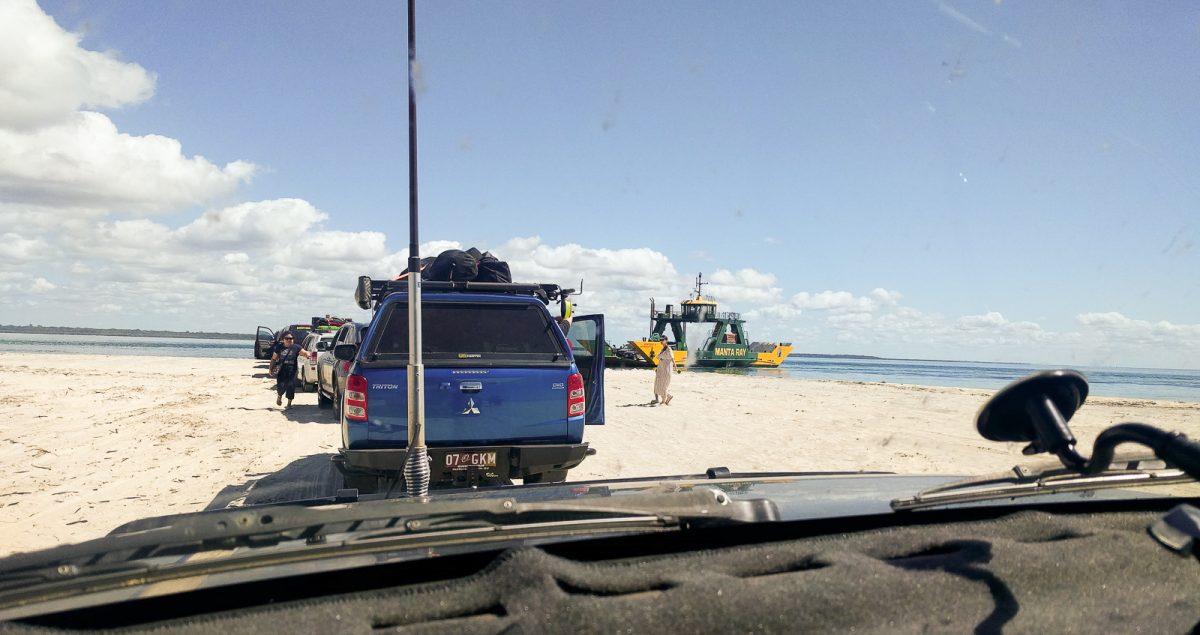
We got off the barge at the south end of the island and joined the convoy of four wheel drives driving up the beach. The tide was moderately high but on it’s way out and we had to drive in the soft stuff, it was boggy but easy going.
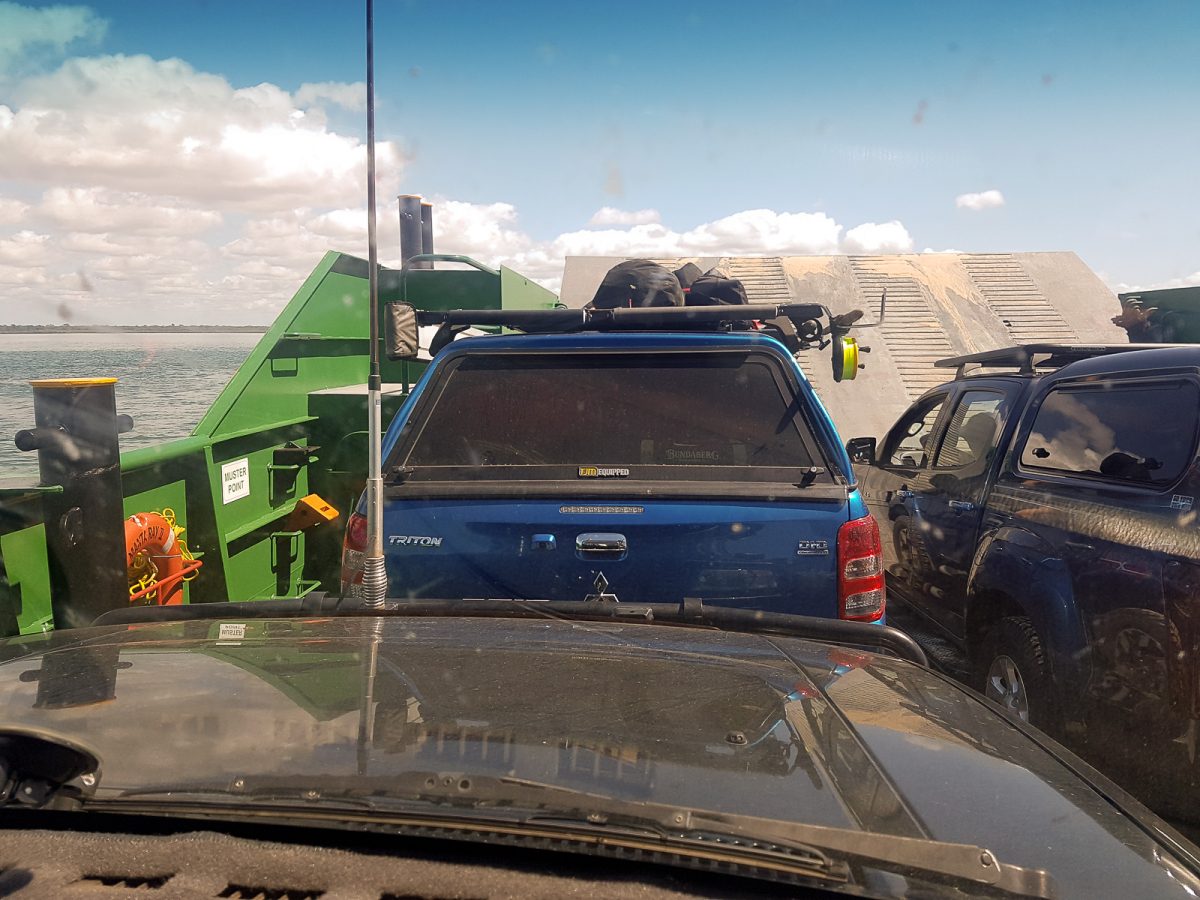
We did go past someone with a whiz bang hard-floor camper who was down to the axles with a couple of mates trying to work out how to get him going again – those things look nice but can be very heavy boat anchors in the soft sand.

After some more driving along the beach I decided to come off the beach and stop for lunch at Dilli Village. A Suzuki Vitara was bogged quite badly at the entrance – apparently these things are ok off road and we saw a few on the island, but don’t really look like they belong there. The owner already had the tyres down to 15psi, but this exit was pretty boggy and steep and the little vitara had bugger all clearance. I used the winch to winch him back out of the hole he’d dug for himself and we went through first – he made it up after us.
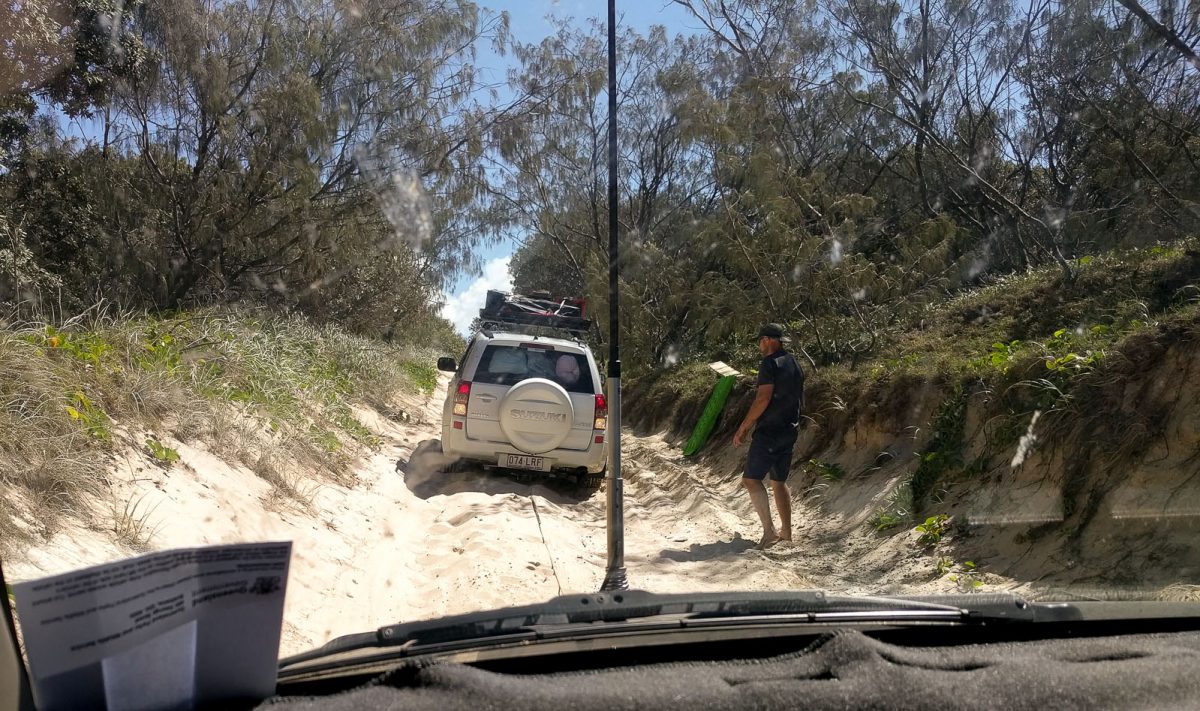
It turned out that the gate to Dilli village was locked so we stopped and had lunch while a wild dingo came up and checked us out from a distance.
After lunch, we took the inland track and stopped at Lake Boomanjin for a swim. The water looks red as it’s stained with tannin from the tea trees. We all had a swim and a bit of a break, it was lovely relaxing in the water. After we’d had enough swim, we jumped in the vehicles and pulled into Central Station, which would be our camp for the next 2 nights.
Central Station is a large camp area in the middle of a forest of huge towering trees, it’s quite dark and cool because you’re under the forest canopy, and the mosquito’s and middgy’s were plentiful. The goannas also seem to just roam around checking things out, so we got used to them poking around pretty quickly.
If you’re going to camp here make sure you coat yourself in bug spray, we got eaten alive and ended up itchy for the rest of the trip. The camp area is well provisioned with toilets, showers and washing up sinks. It feels a bit weird being deep in the forest on an island made entirely of sand!
The next morning we went for a drive on the inland road and tried to get to Lake MacKenzie around the back way, when we realised it was a one-way track (but not marked on the map), we tried to take an alternate route and came across a track closure, so we had to back track past Central Station and joined the crowds at Lake MacKenzie.
The lake is white sand with crystal clear water, paradise! We spent a while here swimming and I also sent the drone up and got some drone shots. After we’d had enough swimming we went back up to the carpark and had lunch in the fenced picnic area, amongst the goannas.
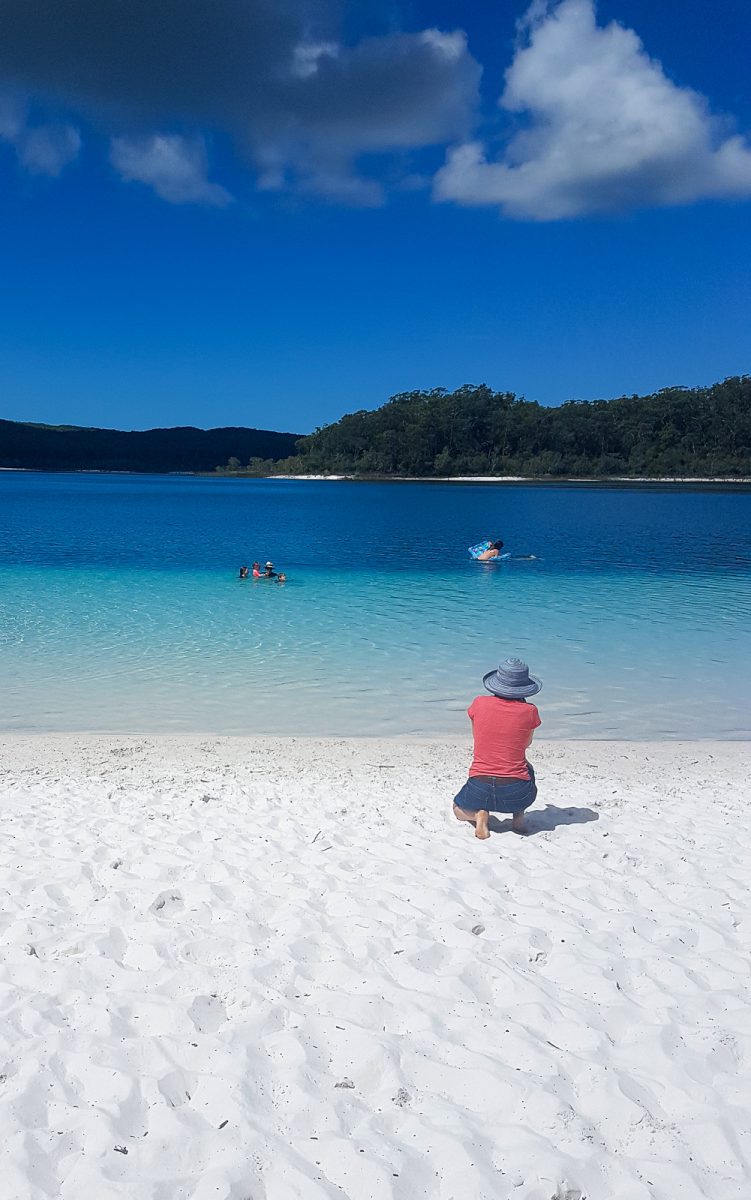
We went back to Central and relaxed for the rest of the afternoon and evening while the kids played.
Day 6 – North up the East Coast to Dundubara
We packed up and went down to the beach on the inland track stopping at Lake Wabby. This is a lake at the bottom of a sand dune, slowly being consumed by the forest on one side, and the sand dune on the other side. One day it will be eaten up by the island and no longer exist.
We went on a short walk out to the lookout to admire the view and took some photos, we decide not to take the kids to the bottom. The dune is very steep and goes straight into a deep lake, and it was going to be a long walk down and back up again, so we decided it wasn’t the place for very young kids.
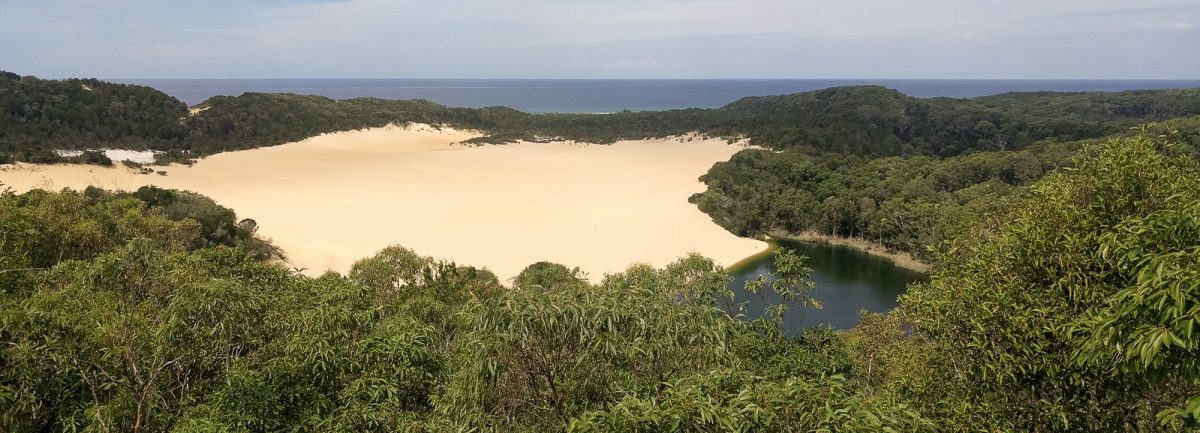
We drove out onto the east beach and continued north. It was pretty easy going and we were getting pretty good at the beach driving. There are a couple of rock outcrops to negotiate through and around – Poyungan Rocks, and Yidney Rocks. The beach starts to become rocky and the track winds it’s way along the rocks and inland via a bypass track, where there are some houses and resorts.
We kept going and stopped at Eli Creek for lunch and a swim. Eli Creek is often pretty packed and today was no exception with several tourist buses, lots of four wheel drives set up along side the creek, and light planes taking off and landing from the beach nearby.
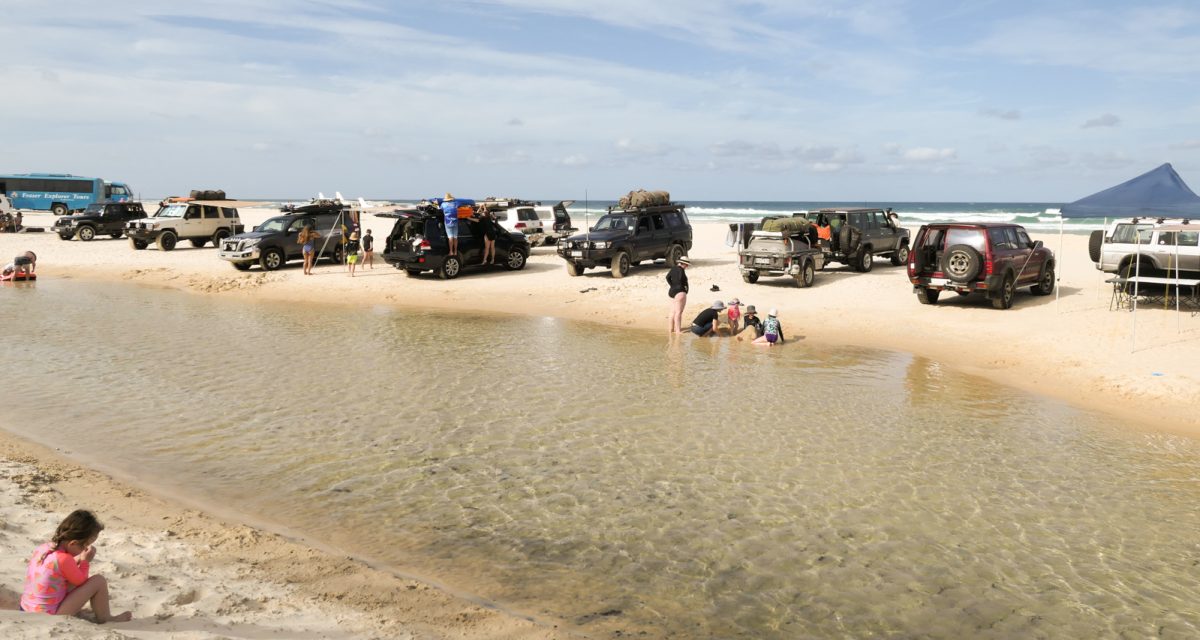
Eli Creek is a shallow, sand bottomed creek. You can take a boardwalk about a kilometer up stream, and then wade back downstream to the beach. It’s a popular spot and the kids enjoyed playing in the sand and water.
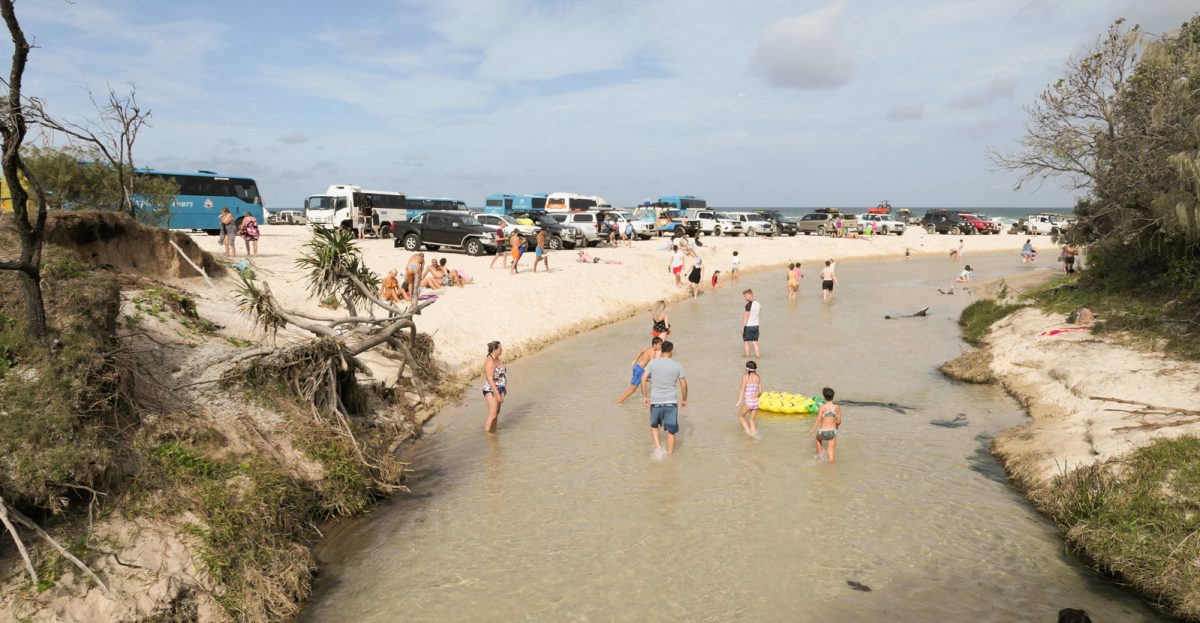
We finally managed to extract the kids from the beach and get the back in the car, and we went to check out the SS Maheno shipwreck. The Maheno was a ocean liner that was used as a hospital ship during the first world war, and was washed ashore on Fraser Island by a cyclone in 1935. It is now a disintegrating, rusted wreck, no one is sure how much longer it will be there, so we got some photos and got back on the road.
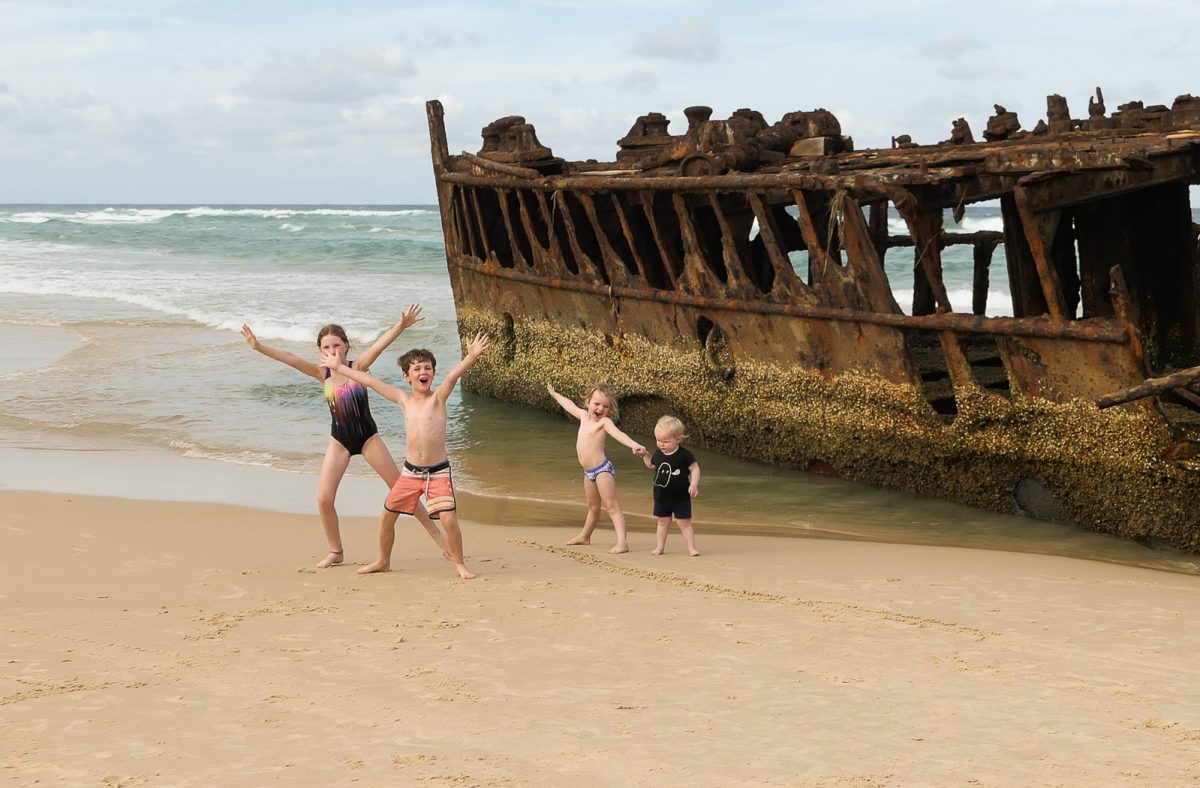
Kids at Maheno Shipwreck 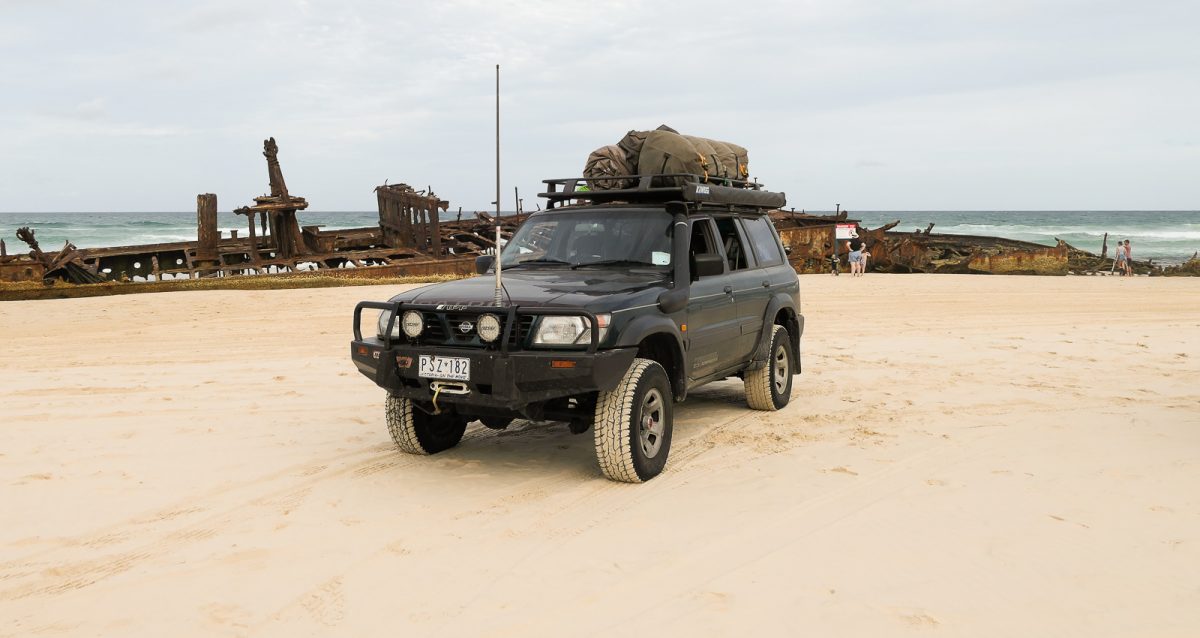
Tim and Kim’s Patrol 
Tim and Kim’s Patrol and Shannon and Bec’s cruiser 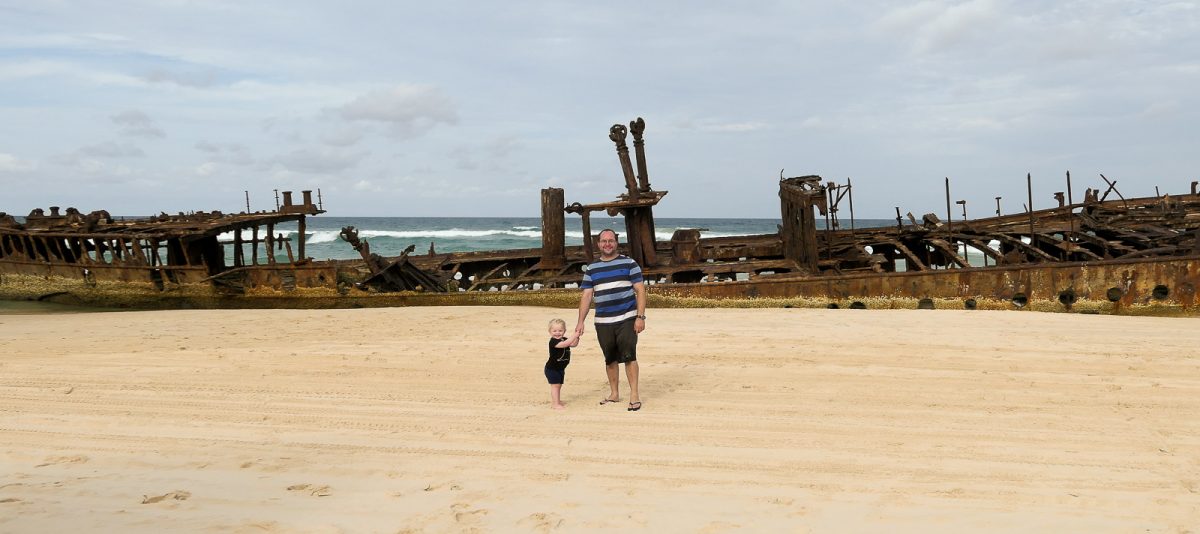
Maheno Shipwreck
We arrived at Dundubara campground, which is a fantastic camp spot. It’s more of a coastal vibe and was a nice change from being deep in the forest in Central Station; it’s also better provisioned with flush toilets and a better washing up area with hot water.
Day 7 & 8 – Waddy Point
We packed up and got back onto the beach, heading north up the island. As we got further north, the sand started getting softer and softer as we approached Indian Head. With Shannon behind me with the trailer, we both just gunned it and kept going until we got off the beach – if we’d stopped we’d have gone down..
The Patrol was working pretty hard getting through the soft sand and I saw the temp gauge creeping up very slightly (we later found out that the radiator had been in need of replacement and was badly obstructed with dried mud and leaves), it didn’t do this again on the trip, but it was clearly causing it to run a bit hot on long stretches of sustained load, and I watched it like a hawk the rest of the trip.
We went around Indian Head, and made the decision to skip Champagne Pools and stop on the way back. We got to Orchid beach before lunch and checked out the shop, then we went back to the camping area at Waddy Point, had lunch and set up camp.
The original plan was to stay two nights here and then spend 2 nights camping on the beach, but we knew there was a bit of rain and wind about to set in, so we called up the parks service and changed over the beach camping to Dundubara, which we thought was a great camp spot.
Once we’d got settled in camp we took off for an afternoon drive up to Ocean Lake for a swim. The kids had fun jumping in the lake from the bank, we went back to camp late afternoon and had a small campfire.
The next day we took the inland track across to the west side of the island, to Wathumba Creek, which is a small campground, and popular with fisherman.
It’s very scenic looking across the creek, and we started swimming in the shallow mouth of the creek, before noticing some small clear jellyfish in the water and had second thoughts. With the kids, and the risk of potentially deadly irukandji jellyfish in Queensland (we don’t know if the ones we saw were irukandji, but those are also small, clear jellyfish), we didn’t want to take any chances, so despite the kid’s protests, we got out and went back to the vehicles.
I later discovered this article, which was published in January 2019 warning people about Irukandji being found at Wathumba Creek, so I realise now that it had been a good idea to stop swimming.
So, after heading back across to the east side of the island, Shannon helped out a stuck Jeep towing a trailer by quickly snatching him, and we went back to the beach, and up to Ocean Lake for the kids to get their swim for the day after a quick lunch. We got on the road back to camp after the aforementioned rain started to come through.
Back at camp, the kids played with frogs in the rain, while the adults battened down the hatches for the rain. The trip had been dry up until now, but we had known in advance that later in the week there was a fair chance of rain. Because of the rain, we got dinner ready and most of us went to bed early.
Day 9 & 10 – Back to Dundubara
Shannon and I were quite keen on doing Ngkala Rocks, we’d heard mixed opinions on the condition of the track, because a cyclone had come through earlier in the year and we’d had a few reports from people who had attempted it and had to turn around. The four wheel driving on Fraser isn’t difficult, but the bypass track around Ngkala Rocks is apparently very soft and heaps of fun to drive. Looking at the timing for everything, the weather, the tides and what we wanted to do for the next couple of days, we decided to give it a miss. We will be back!!
We packed up our wet camp and headed back south along the beach. Champagne rocks are a natural rock formation. You park up at the car park and walk down to the rocks along a boardwalk. The rocks are a formation of rock pools that create a natural swimming hole with the waves crashing over the rocks into shallow, sandy pools.
We had a swim here for a while, with the kids having a great time, and then we got back into the vehicles after having some of Bec’s brownies.

View from boardwalk at Champagne Pools 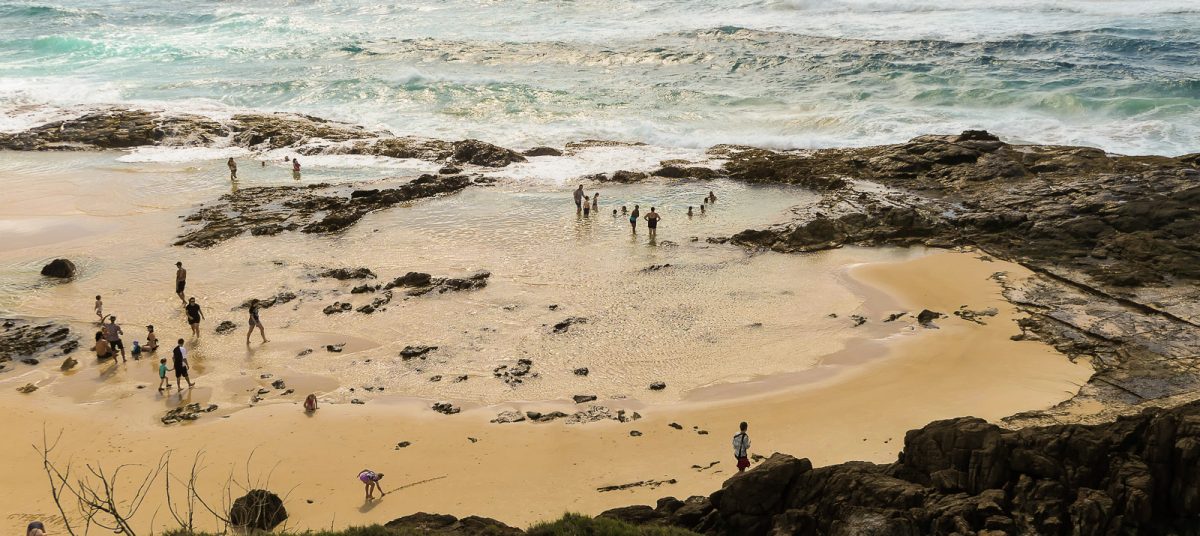
Champagne Pools 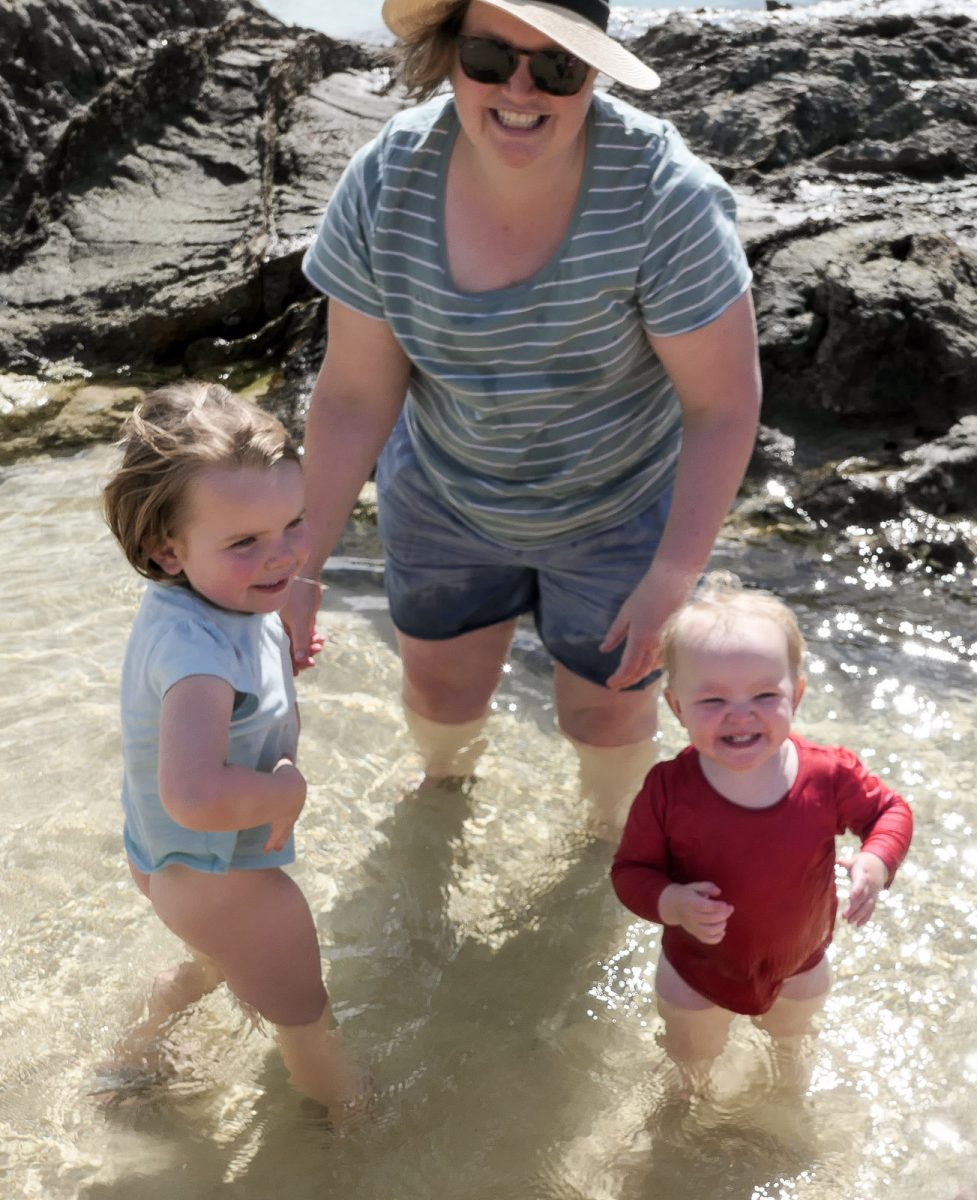
Kim and the kids at Champagne Pools 
View from boardwalk at Champagne Pools
We headed south on the beach, set up camp and had lunch, then we got back in the vehicles for another swim at Eli Creek. It was not crowded at all this time, and we think it was because we were close to high tide (none of the tourist buses or tourist hire 4wd’s were out and about, so I assumed they have strict instructions to never drive close to high tide).
We left Eli Creek about 2 hours prior to high tide, the plan was to explore inland and come back along the beach after high tide. We took the beach down a bit further south to Happy Valley and got off the beach, and stopped in at the pub & general store. After picking up some snacks and supplies, I also made an executive decision to book us in for the pub for tea, and then we went off to go for a drive on the inland track to Lake Garawongera.
This was a great track, it twists and turns deep in the forest, with a few interesting steep bits and steps made by eroded tree roots. It was a nice change to have a couple of interesting technical challenges after all of the beach driving, so we enjoyed driving through the forest.
Lake Garawongera was awesome, this was another clear, sandy lake with some reeds. We enjoyed our third swim for the day and after we’d finished we took the track back into Happy Valley, and settled in at the pub for a couple of beers and some dinner while we waited out the tide.
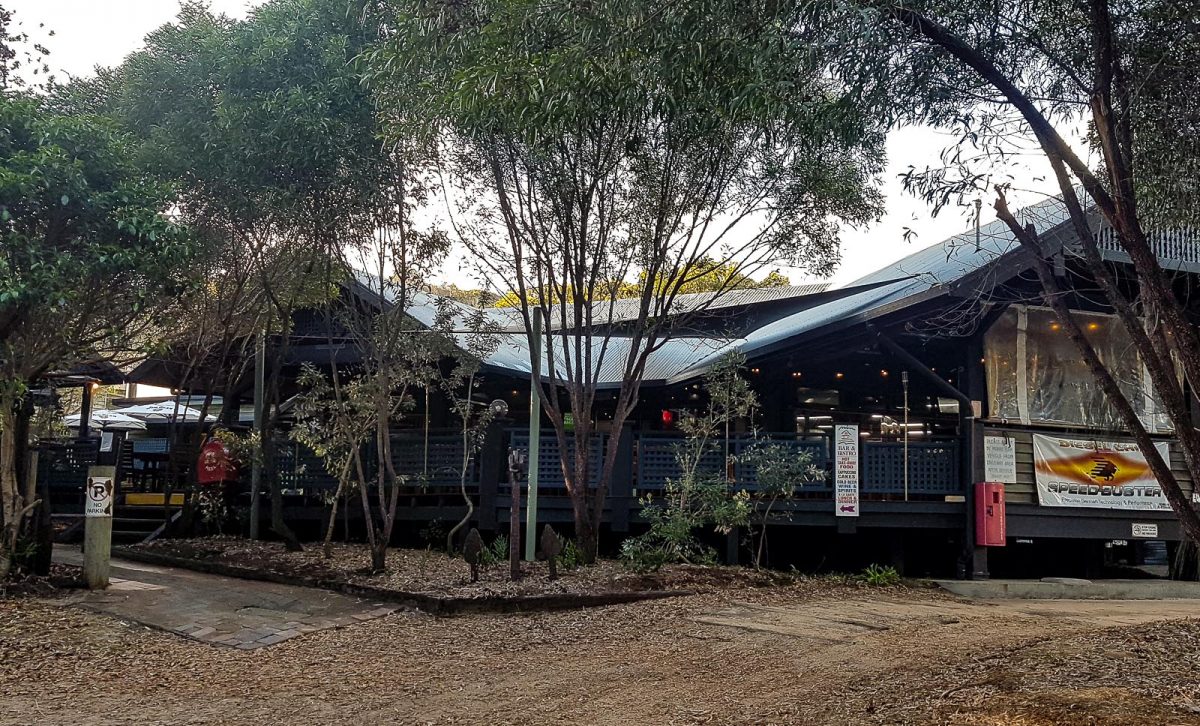
We did a night drive on the way back to camp along the beach. The beach looks a lot different at night and it’s harder to predict where the wash-outs and exposed coffee rocks are, but we took it at a slower pace and made it back to camp late evening.
The next day we went to check out Lake Allom, this is not a swimming lake (but you can kayak), it is a habitat for lots of turtles, so we sat at the lake edge watching the turtles swim around.
Shannon, Bec, and their kids + Pip went for a walk around the lake, while Kim, Myself and Libby hung out at the picnic tables near the carpark, and spontaneously decided to cook up some sausages for lunch – it’s not the first time I’ve loved having everything for cooking ready to go in the back of the Patrol!!
We got back on the road after lunch and stopped along the way back to camp to go for a short walk to a lookout overlooking knifeblade sandblow.
We went back to camp for the afternoon, and this is when more rain kicked in. The afternoon/evening activities consisted of: staying out of the rain, diverting water around the tents, and rearranging awnings to make the most non-rainy space available for everyone. We did a bit of drawing and reading books, and we enjoyed having a few drinks, sitting around the camp table that we’d managed to get the awning over before the rain hit.
This was our last night, and I’d pretty much made the decision after the rain, to just get packed up as quickly as we could and book it back to the ferry, so we got the camp ready to pack up quick in the morning.
Day 11 – off the island and back on the road
We got on the road early, by around 7am and the others left a bit later in the morning, the first stop was at the bakery in Eurong, where we got some pies and sausage rolls. Eurong is the biggest town on Fraser and is home to some larger resorts, a sizeable general store and a bakery.
We took some drone footage along the way, with the drone following the 4wd along the beach, which looks great, but I regret not doing it earlier in the trip with both vehicles.
The tides were just right and we were able to drive on the beach up to the 80km/hr speed limit, so we did good time and made it back to the ferry mid-morning. While we were waiting for the ferry there was a pack of 3 dingo’s sniffing around the cars – they look cute but they can get aggressive and you need to be vigilant, especially with kids.
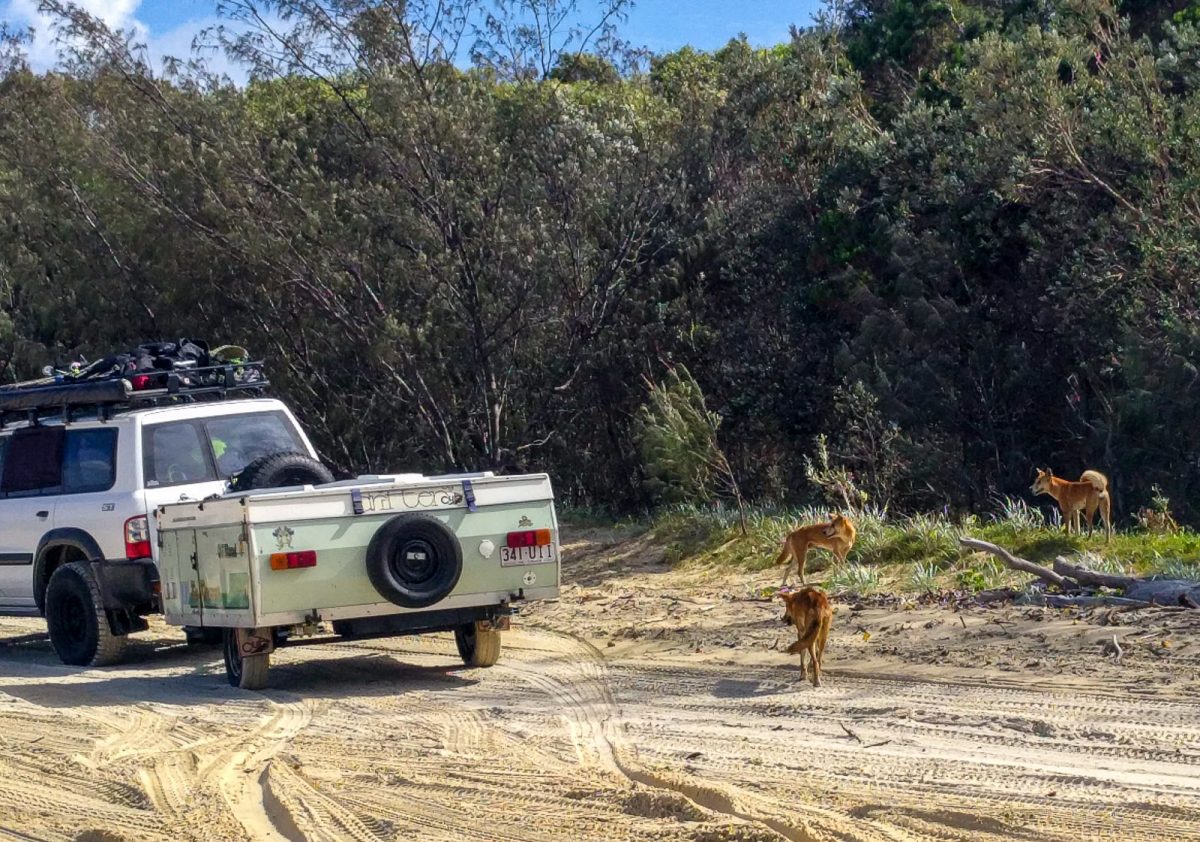
The drive back to Bendigo took us 2 days, having left Dundabrra at 7am on Monday, and getting back to Strathfieldsaye just past midnight on Tuesday night, close to 22 hrs driving over 48 hrs. It was a bit of a slog, but doable with 2 drivers and kids who are used to it. We stopped every 2 hrs at a town with a playground – we were glad to have a couple of days with the kids in daycare to unpack and get the house back in order before a busy Easter; in hindsight we’ll probably do it over 3 days next time.
Shannon and crew took a more leisurely time back home and stopped in a few places along the way.

Final thoughts
Overall, it was an amazing trip and Fraser is perfect for both adults and kids of all ages. We skipped past quite a bit, but we also slept in, sat around and did nothing and let the kids enjoy themselves and swim every day.
It is wise to expect some rain, no matter what time of year you go. Someone told us that it’s always raining somewhere on the island, I think we were lucky to get so many clear days, it was only really 2 evenings where it rained heavily, it definitely didn’t spoil the trip, but it did encourage us to leave early on the last morning.
The 4wd’ing isn’t challenging with some simple tips:
- don’t drive too fast on the beach
- be careful of the washouts
- know the tide times and don’t drive near high tide
- 15psi
- don’t tow a heavy trailer unless you really know what you’re doing
You don’t need a modified vehicle or bigger tyres, just something that’s a proper 4wd with some ground clearance, a recovery kit and recovery points, a shovel and common sense.
Overall, we really appreciated Shannon and families company, and we were very grateful to have them on the trip.
-Tim
